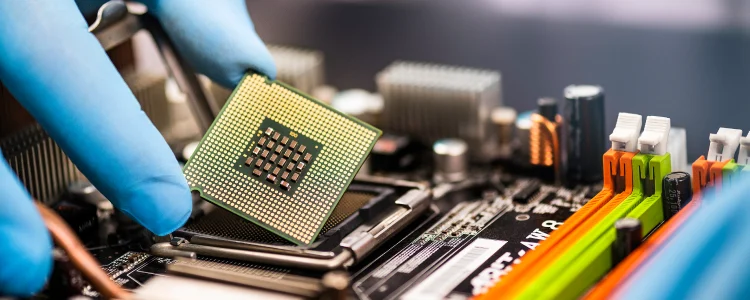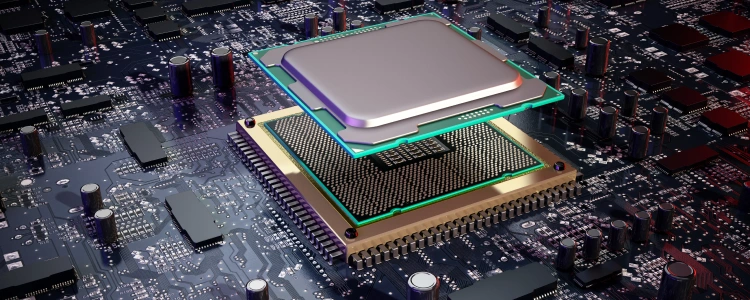Intel vs AMD – Which Is The Better Option In 2025?

At the heart of your pursuit for a new or upgraded server lies an important decision: Should you use an AMD or Intel processor? Intel is a solid choice for users seeking high-end performance and don’t mind a higher price-point, while AMD shines in gaming scenarios with its innovative X3D technology.
There is much to consider when choosing your processor, and that’s where ServerMania comes in. We have the technical know-how and experience to build and maintain enterprise servers with processors like Intel and AMD. Our team has been building high-performing servers using the latest Intel and AMD chips for over 20 years.
If you’re building your own supercomputer, there are plenty of criteria to look at, like what operating system you use, what graphics card will be best for you, and where exactly you can buy all these components.
Whether you are looking for gaming performance, database hosting, or simply dedicated server hosting, you must be aware of the fierce battle for CPU dominance between these two titans and the AMD vs. Intel battle that has grown over the last few years.
Whether you’re looking at CPUs like the AMD Ryzen 9 7950X or the Intel Xeon W series processors, there are plenty of great features to explore. So let’s get this side-by-side comparison started by looking at the history of both the AMD and Intel processors.
Historical Significance of Intel and AMD
These two tech companies have dominated the processor market for decades. They’ve been competing to provide the fastest, most competent, and feature-rich CPUs for gamers, casual web surfers, and professionals for years.
AMD was founded by a couple of tech geniuses who focused heavily on gaming. On the other hand, Intel pioneered the x86 CPU architecture, which powers most PCs and laptops today and has owned the market since the 1980s. The rivalry started in 1991 when AMD released the Am386, a clone of Intel’s 80386 chip, demonstrating that AMD could produce competitive x86 chips while avoiding Intel’s patents. In 1997, AMD released the K6, which shocked the industry by exceeding the performance of Intel’s Pentium II and sold at a lower price.
Over the years, AMD has come out with some truly innovative designs, and Intel has responded with its own truly revolutionary chips. AMD’s marketing team seemed to struggle to get the same exposure that Intel garnered. Around this time, they started targeting the PC gamer and improved their packaging, using different color schemes and taking a new approach to their marketing efforts. At this time, Intel already had a firm grip on flagship performance, but AMD really turned things around with the release of its Ryzen processors.
In AMD’s favor, they have historically offered more value in their processors, while Intel holds the reins with stronger brand recognition (the Nike of microprocessors).
AMD and Intel are currently in a battle for market share and are developing different technologies in their effort to get ahead. For example, Intel uses LGA 1200 which is twice as fast as RAM for their processors, while Ryzen chips rely on AM4 sockets, meaning that components such as motherboards must be chosen accordingly, or they will be incompatible.

Intel vs AMD Processors Explained
As is the case for any brand, they usually have names for each model or series. AMD offers its Ryzen processors: Ryzen 3, Ryzen 5, Ryzen 7, Ryzen 9, and EPYC lines, while Intel offers its Silver, Gold, and Platinum lines as part of its Xeon brand.
AMD has always been a viable option for processors and has only improved with its Ryzen series of CPUs. The most recent line, AMD Ryzen 3, 5, 7, and 9 chips, incorporate solid multi-core performance at a lower price point.
Intel’s Xeon W series processor, Sapphire Rapids, was released in Q1 of 2023 and uses the Golden Cove architecture, the LGA 4677 socket, and supports DDR5 ECC RAM and PCIe Gen 5.
AMD’s Ryzen 9 CPUs offer a significant difference over the previous Ryzen 5 and 7 CPUs. It offers high clock speeds, high core counts, and raw performance power. It can also provide a performance boost for certain applications, especially those that rely on large datasets. Ryzen 9 CPUs are so much in demand that it is very difficult to keep them in stock.
AMD’s 10nanometer architecture has up to 60% lower power and 25% better performance than Intel’s initial 14nanometer process. AMD processors are therefore more power efficient and run cooler. The 7nm process is based on FinFET (fin field-effect transistor) technology, a type of multi-gate MOSFET technology. The reduction in transistor sizes, from 14nm to 10nm and now to 7nm, has enabled faster processing speeds and improved energy efficiency.
Take the AMD Ryzen 9 5950X dedicated server; it comes in at a reasonable price and has incredible performance improvements over the last generation, making it one of the best processors currently available. They still use AMD’s AM4 CPU socket, which means that they are backward and forward compatible, while Intel holds a long history of releasing new processors that are incompatible with older socket types.
AMD’s continuous use of AM4 sockets over the previous generations has provided users with tremendous value concerning future upgradability. For instance, if you were using a 3900 chip on an ASRock motherboard, upgrading to the new series is as easy as downloading a BIOS update for your board. The odds of being able to take an old Intel chip and put it in your newer motherboard or vice versa are slim on Intel’s side.
Browse ServerMania Dedicated Servers

AMD vs Intel Performance Comparison
AMD changed its strategy a few years ago and focused on gaming performance to take market share from Intel by releasing the 3000 series. The CPU performance of this line showed the same gaming performance with a marked increase in workload capacity.
The AMD 3900X features 12 cores, 24 threads, a base clock speed of 3.8GHz, a boost of up to 4.6GHz, and a TPD of 105W. The AMD Ryzen 9 5950X dedicated server is one of their top server processors with 16 cores, 32 threads, a base clock speed of 3.4 GHz, a maximum turbo boost of 4.9GHz, and a TPD of 105W. Both of these chips are phenomenal, making them perfect for high-end gaming or multimedia editing.
Upon first glance, you would think that the Intel Xeon W9 3495X might not compare. To begin with, the price is dramatically higher than the Ryzen 9 5950X. Seeing how Intel Xeon W9 3495X comes with 56 cores, 112 threads, and a base clock of 2.0 GHz, with a max boost to 4.8 GHz, these CPUs are perfect for high-end gaming or creative tasks such as 4K video editing or 3D rendering, which requires a large amount of power at an affordable price.
Conversely, AMD’s top-of-the-line variant, the Ryzen Threadripper 3990X, is in a league of its own with high clock speeds due to its 64 cores and 128 threads. It has a base clock speed of 2.9GHz, a boost speed of up to 4.3GHz, and a TPD of 290W. Thanks to its multi-threaded performance, this processor is an all-purpose workhorse that can be used for VPN, large data computations, AI, and military applications.
On the Intel side, their Xeon Silver 4214R is comparable to the Ryzen 3900X, also featuring 12 cores and 24 threads, but the clock speed on this one is lower, with a base of 2.4 GHz, a max. of 3.5 GHz and a TPD of 100W.
While the Intel E5 2620 V4 matches AMD for cores, coming in at 16, again, they fall just a little short on clock speed, with the 2620 V4 having a base speed of 2.1 GHz and boosting as high as 3.0 GHz. The TPD is 85W.
It’s difficult to compare most other processors to AMD’s Ryzen Threadripper, but the Intel Xeon E5-2699 v4 scalable processor compares very well, coming in with a core count of 22, making the thread count 44. The base clock on this chip is 2.2 GHz, while the max. boost comes in at 3.6 GHz.

Overclocking Headroom
Intel processors have commonly had the most overclocking headroom, which gives you more over-the-baseline speed performance and, in the past, allowed for higher frequencies than AMD Ryzen CPUs. Still, it is also worth considering how stable your CPU will be with such high clock speeds. Here are some of the other popular Intel models that compare to AMD’s Ryzen 9 line.
| CPU Processor Frequency | Base Frequency | Max. Turbo |
|---|---|---|
| AMD Ryzen 3900X | 3.8 GHz | 4.6 GHz |
| Intel Xeon Silver 4214R | 2.4 GHz | 3.5 GHz |
| AMD Ryzen 3950X | 3.5 GHz | 4.7 GHz |
| Intel E5 2690 v4 | 2.6 GHz | 3.5 GHz |
| AMD Ryzen 3990X | 2.9 GHz | 4.3 GHz |
| Intel Xeon Gold 6338 | 2.0 GHz | 3.2 GHz |

AMD Ryzen vs Intel Xeon
With the increased market demand for AMD Ryzen Servers, vendors have had a hard time keeping enough of them in stock to service demand, since they often sell out before even hitting the data centers (and this is especially the case here at ServerMania). AMD cannot keep up with demand, with many people reselling or hoarding the 3900s for crypto. The scarcity of hardware is currently an issue for AMD, whereas Intel’s long history has allowed for a more reliable supply chain.
The most popular CPU among enterprise customers is the beast we know as the AMD Ryzen Threadripper 3990X. This CPU offers plenty of power and speed with its remarkable 64 cores and 128 threads, making it the most powerful processor for product performance. This affordable processor is based on their Zen 2 microarchitecture and is fabricated on TSMC‘s 7 nm process. It also supports 64 PCIe lanes at 4.0.
A comparable processor would be the Xeon 6338 Gold Series, which has a powerful 32 cores and 64 threads, a base clock speed of 2.0 GHz, and a max. turbo frequency of 3.2 GHz. This processor is based on the X86 architecture and is highly sophisticated, allowing the Xeon line to suit a wide array of complex applications. Like the 3990X, this processor also supports 64 PCIe lanes at 4.0. It is worth mentioning again that Intel chips come with an integrated graphics card, whereas AMD does not.

AMD EPYC Considerations
The war for domination must include AMD’s EPYC Series. Released two months prior to the Ryzen 3950X was AMD’s EPYC 7402P, a 64-bit tetracosa-core x86 server microprocessor with 24 cores and 48 threads. It has a base clock at 2.8GHz, a max speed of 3.35GHz, and a 180W power rating. This processor supports single-socket configurations only and up to 4 TiB of eight channels DDR4-3200 memory per socket. The EPYC 7402P is based on the Rome 7nm family and is part of the EPYC series.
Due to its massive memory bandwidth, capacity, and exceptional I/O, this monster of a server processor is designed for intensive computational tasks such as artificial intelligence (AI) and high-performance computing such as industrial or military applications.
Price Comparison
AMD holds the title for being the most affordable of the two; however, Intel has been doubling down on AMD’s increased competitiveness over the past few years by adding more cores, threads, and power to the mix. Unlike an AMD processor, there is no increased gen-on pricing for these new processors, resulting in a better price-per-core and price-per-thread. As a response, AMD reduced its prices and stepped up the competition.
If you want an AMD Ryzen 9 (16 cores), you would be looking at a price in the vicinity of $600-800, whereas a comparable Intel processor with fewer cores, the 2699 E4, would cost around $4000. However, if you wanted a Xeon E5 2690 (14 cores), you would be looking at only $2000. Choosing the best Intel Xeon processor is entirely up to you.
You should note that the Ryzen line does not offer dual CPU formats until you get to the EPYC, which will cost around $4000-$5000 per chip. If you do go with AMD, you will be required to purchase a separate dedicated graphics card.

Consumer vs Enterprise CPUs
Not all CPUs are made the same. The CPUs built for servers are meant for sustained workloads and can run at 100% capacity all the time, whereas the parts in desktop processors are not rated as high. Because of this, server CPUs are generally more costly than those for a desktop PC, but they also offer a higher level of productivity performance.
Most desktop processors cannot handle server-only functions, such as error-correcting codes and registered memory. The biggest difference between the two is that server CPUs will, more often than not, have higher core counts than those used on a desktop PC, which results in higher power consumption. This is because server workloads are much more multi-threaded than most desktop workloads due to the extra cores.
Intel processors have enjoyed supremacy in this segment for years, but AMD’s Ryzen Threadripper has changed the landscape quite a bit since its release. AMD traditionally doesn’t distinguish between its server processors and the desktop space. The AMD CPU used in servers are consumer-grade chips that are so powerful that they work incredibly well in servers (in 2017, AMD released their EPYC line, built specifically for servers). Whereas Intel has nearly always had a line of processors designed specifically for servers.

Which is the Best CPU?
Whether AMD or Intel makes better CPU design is a debate that will never end. This piece has covered both sides of the debate. It depends on what you want and whether you like AMD or Intel better.
No matter which server you choose, CPU performance is about the same. The main difference between Intel and AMD is price. So, let’s say you want a lot of cores in the top section. In that case, AMD CPUs are better because they have more cores and threads and a better performance-to-price relationship. If you compare prices and performance, the Xeon E5-2695 v2 is better because Intel’s base chipset can support two CPUs.
We know that some people don’t have time to look into all of their choices, and the data online can be difficult to understand. You can talk to one of our experts about server hosting if you book a free consultation. They will answer any questions you have about server hosting and there is no pressure or cost to you.
Browse our Intel and AMD Dedicated Server Options. if you need more help choosing between AMD’s Ryzen processors and Intel’s Core series, which have similar features but different prices, or if you need help figuring out what kind of processor might work best for you.
Frequently Asked Questions
Q: Is AMD better for workstations and content creation?
A: Of course, AMD’s higher core counts give them an advantage for multi-threaded workstation apps like video editing, 3D modeling, and rendering.
Q: AMD or Intel, which performs better on computers?
A: In most cases, Intel Tiger Lake is faster than AMD Ryzen 5000 mobile when only one thread is being used. However, AMD is faster when multiple threads are being used. Overall, they offer about the same speed as laptops.
Q: Which of them takes the lead when it comes to laptop battery life?
A: With the 11th-generation Tiger Lake, Intel has regained the lead in laptop battery efficiency over AMD Ryzen mobile chips.
Q: Which of these processors have more advanced manufacturing?
A: AMD is ahead because they were the first to switch to the 5nm technology. Intel had trouble getting to 10nm on time and are now using 7nm instead.
Q: Which has a better gaming performance, Intel or AMD?
A: When you compare the latest AMD Ryzen 5000 and Intel 11th gen Core desktop CPUs for game speed, AMD comes out on top. But Intel is still ahead for some games.
Was this page helpful?

